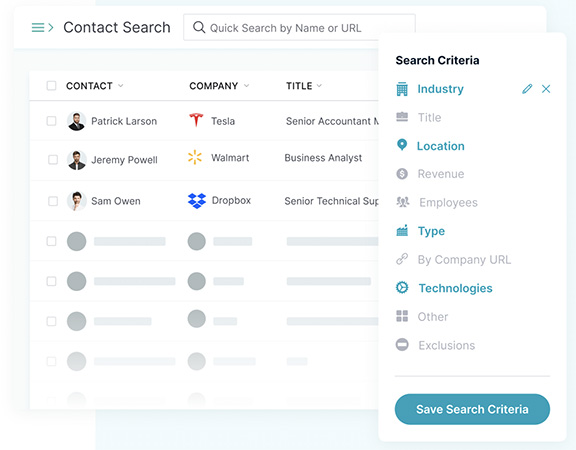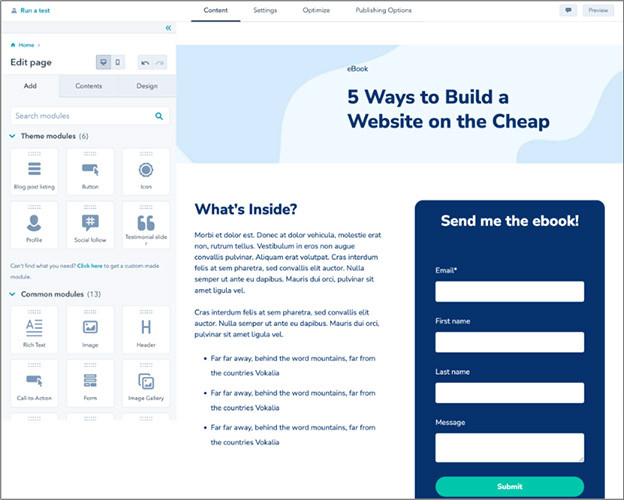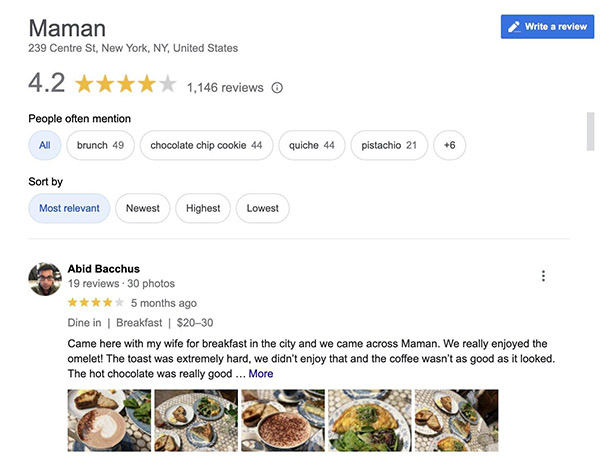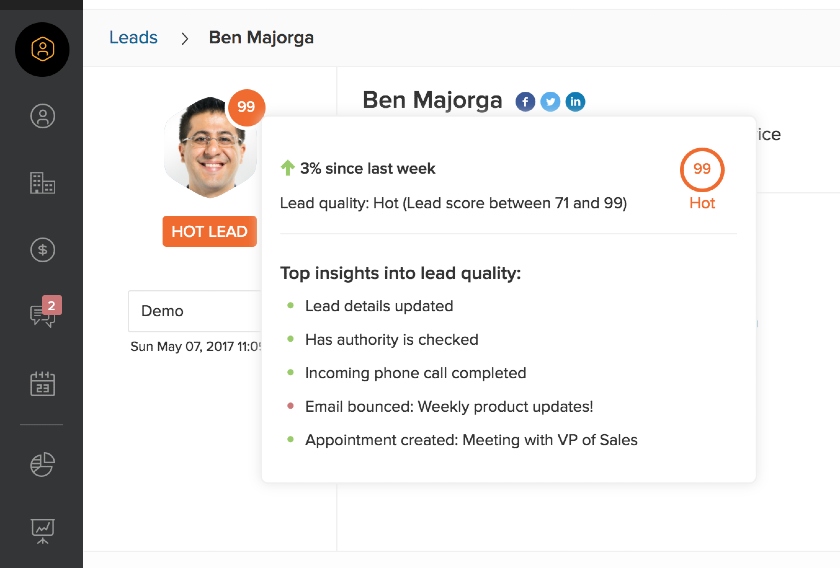Lead generation involves trial, error, and testing to see what works best for your unique business. That’s why following a particular process on how to generate leads in sales is crucial. It ensures you cover all your bases and measure the effectiveness of your activities. In this article, we explore the steps to generate sales leads for your business—from determining your target audience and strategy to initiating your call-to-action (CTA) activities and continually assessing your strategies.
Free Lead Generation Template
As you generate leads, use our free template to identify and organize your team’s lead generation activities. This template will be instrumental in tracking your sales targeting activities, helping determine the target audience interested in your products and services, and guiding you to create a custom lead generation strategy.
Thank you for downloading!
💡 Quick Tip:
Use a CRM tool to record lead information and score their likelihood to convert.
Consider providers like Freshsales that scores leads based on website activity, professional background, and previous purchase history.
Below are six steps on how to generate leads in sales for your business:
1. Determine Your Target Audience
The first step in learning how to generate leads in sales is understanding what an excellent lead looks like, as this dictates the channels and the specific tactics you use. One way to determine your target audience is by creating a customer persona. Personas represent your ideal buyers based on their demographics, interests, behaviors, roles, and job responsibilities.
Did you know? 91% of businesses consider lead generation as their most important goal. (Source: Ruler Analytics)
As personas are developed, you can determine the channels, messaging, and calls to action to attract each type of ideal customer. For information and a free customer persona template, check out our guide on how to create a customer persona.
Thank you for downloading!
💡 Quick Tip:
Customer relationship systems like Zoho CRM allow you to store customer persona information and use tagging features to add traits to each prospect–making it easier to segment your customers into personas.
2. Decide Whether To Use an Inbound or Outbound Strategy—or Both
The second step in how to generate leads in sales is determining your strategy. Once you know the “who,” establish whether you want to do an inbound, outbound, or hybrid strategy. You can also narrow down the specific tactics you wish to use, and it’s important to note that different personas may require other tactics.
For instance, if one of your target audiences is younger and another is much older, you may need to use different tactics for each. Social media campaigns may appeal to the younger demographic while calling, emailing, or traditional advertising to reach older audiences.
Did you know? Inbound lead generation involves potential customers coming to you through tactics like content marketing, website form submissions, traditional advertising, and social media campaigns. Meanwhile, outbound lead generation involves actively finding and engaging potential customers through tactics like cold calls, email introductions, and networking events.
Your team’s skill sets, experience, and resources also affect how you plan to generate leads. For example, you can assign sales team members to a specific lead generation activity based on their past experience—making it faster and more efficient to generate leads. It makes sense to assign an agent with previous cold calling experience to cover the same kind of activity, as they are already familiar with the ins and outs of reaching out to entirely new leads.
The chart below indicates the required attributes when using different tactics for business-to-consumer (B2C) or business-to-business (B2B) lead generation activities:
Tactic | Budget Requirements | Primary Skills/Resources Required | Good for B2C? | Good for B2B? |
|---|---|---|---|---|
Referrals | Little to no cost | Robust network and sales skills | ✓ | ✓ |
Content Marketing | Can be expensive, especially if outsourced | Creative, copywriting, SEO, graphic and web design, and other digital marketing skills | ✓ | ✓ |
Traditional Advertising | Relatively expensive | Creative and copywriting skills | ✓ | ✓ |
Paid Search Advertising | Can be expensive, especially if outsourced | Search engine marketing (SEM) and copywriting skills | ✓ | ✓ |
Website Form Submissions | Little to no cost | Digital marketing and design skills | ✓ | ✓ |
Social Media Campaigns | Can be expensive, especially if outsourced | Creativity, copywriting, graphic design, digital marketing, and social media management skills | Depends on channel | Depends on channel |
Educational Seminars | Little to no cost if virtual but can be expensive in-person | Public speaking, professional knowledge, and some sales skills | ✓ | ✓ |
Purchasing Leads | Moderately expensive | No specific skills required | ✓ | ✓ |
Cold Calling | Little to no cost | Professional sales skills | N/A | ✓ |
Little to no cost | Creativity and sales skills | ✓ | ✓ | |
Networking Events | Can be expensive depending on event | Robust sales skills | ✓ | ✓ |
Trade Shows | Relatively expensive | Sales skills and excellent marketing materials | ✓ | ✓ |
Pro tip: Utilizing these tactics and channels will help you acquire leads. However, remember that quality leads are always better than a long list of names that might not convert to customers. Read our guide on the BANT sales method to learn about the best ways to qualify your incoming leads.
3. Execute Your Tactic
The third step to generate sales leads is executing your tactic. Doing this with solid messaging and communication is as important as choosing the right one—offline or online lead generation. Based on the target audience, each tactic will determine the message, how it’s sent, and where. For example, when cold calling, the message is an initial elevator pitch using a cold calling script over the phone.
For content marketing, the message is the topic or main point within the content delivered, which a lead can consume by visiting your website or social media channel. Trade shows use branded items, posters, and signs to deliver your message. Educational seminars or webinars require a choice of location (online or offline), the development of audience-valued content, and a CTA that ties back to your business’s unique value proposition or offerings.
One last thing to consider for the execution stage is whether or not you want to do it in-house or use a contractor. For example, a lead generation company can conduct cold calling and introduction emails on behalf of your business.
Similarly, creating content or ads, designing pages on your website, and managing social media can also be contracted out to marketing agencies or freelancers. While it may be more expensive, the return on investment (ROI) of outsourcing tactics to experts may be well worth the cost.
Pro tip: If you don’t have in-house resources to create content and design ads, you can outsource freelancers from platforms like Upwork and Fiverr. These platforms have a large talent pool that can provide professional-looking resources. Check out our guide on the best websites to hire freelancers for more options.
4. Initiate a CTA
The next step on how to generate sales leads is initiating a CTA. No matter what tactics are used or whether the tactic execution is done in-house or outsourced to another firm, it must be followed by a CTA. A compelling CTA gets the prospect to show they are interested and become a qualified lead. Below are some examples of initiating a CTA based on the tactic employed:
Tactic | CTA |
|---|---|
Content Marketing | After a video, article, or podcast, let the audience know they can learn more by calling your number, emailing your business, or submitting a website form. |
Traditional Advertising | In the advertisement, specify the number they can call, the website URL to visit and fill out a form, or the email address they can use to contact your business. |
Paid Search Advertising | Use buttons that signal the next step to the audience. It could say “shop now,” “click here to learn more,” or “sign up for an appointment.” |
Social Media Campaigns | Use buttons that signal the next step to the audience. It could say “follow us on @accountname” or “check out our website to learn more.” |
Cold Calling | During the call, initiate the next step by setting up product demos, sales presentations, or getting their email address to send more information about your product or service. |
Email Introductions | State in the email they can check out your website, call you, or respond to the introduction email to learn more or move to the next step. |
5. Measure Effectiveness
The fifth step on how to generate sales leads is measuring the effectiveness of your efforts. As you execute tactics and initiate CTAs, measure the effectiveness of your strategies based on how many people respond to the CTA. There are many ways to measure effectiveness for all types of channels when generating new business leads.
Below are some metrics to consider:
- Sales qualifying lead (SQL) rate: For direct sales activities like cold calling or emailing, this is the percentage of leads interested in learning more in a presentation, demo, or receiving pricing information.
- Actionable lead rate: If you purchase leads, this number is the percentage of contacts in which the contact information is accurate.
- Cost per engagement: If you are running an ad or social media campaign, this is the total amount of money spent divided by the total number of people who interacted with your campaign. Interaction could include responding to the CTA or clicking on the ad.
- Cost per lead: This is the total amount spent for a lead tactic or specific campaign divided by the total number of leads generated.
- Total return on investment (ROI): This is the percentage of revenue generated from a lead tactic or a specific campaign divided by the cost of deploying it.
- Lead-to-sales ratio (closing rate): The percentage of deals closed based on the total number of leads generated. This is a crucial metric because it tells you how many leads you need to generate to close a particular amount of deals. For example, if your closing rate is 5% and you want to close 40 deals, you must generate 800 leads.
Pro tip: Sales metrics extend beyond numbers. They show overall growth potential and track all parts of the sales process. For more sales metrics to help you analyze your sales operation, check the top sales metrics to improve your performance.
6. Review Your Strategy Continually & Adjust As Needed
There’s no sense in measuring the effectiveness of your efforts if you don’t plan on doing anything with those numbers. Finding the best tactics for your business involves trial and error, and metrics show you what’s working and what isn’t. Knowing this, you can adjust your strategies and tactics accordingly.
The numbers might show an overall tactic isn’t working or that one method is working better with one customer persona over another. For instance, let’s say you are running a cold calling campaign and an online ad with video content targeting business owners and information technology (IT) directors. During each of those campaigns, your sales qualifying lead rates are as follows:
- Cold calling business owners is 3%
- Cold calling IT directors is 10%
- Video content for business owners audience is 7%
- Video content for IT directors is 2%
This tells you cold calling is more effective when targeting IT directors while video content is better for business owners. That said, you should adjust your strategy and get more contact lists for IT directors to cold call while adjusting your online ad campaigns to target more business owners.
Pro tip: Interested in learning more about cold calling? Check out our article on cold calling statistics to explore interesting data that will help you develop your lead gen strategy.
Tools for Lead Generation
Generating leads is far easier when you have the tools to organize information, streamline processes, automate tasks, buy leads, and facilitate strategy execution. Below are some sales management software tools for buying leads:
UpLead is a B2B prospecting tool that provides reliable contact information about high-quality leads, including mobile numbers, verified email addresses, and professional profiles. It also allows you to have a targeted search for prospects by filtering them using location, industry, revenue, and company size. It can also integrate with customer relationship management software (CRMs) so your leads and their information are easily saved in your contact database.

UpLead makes it easy for users to search for leads through advanced filtering tools.
(Source: UpLead)
Landing pages are a great way to acquire leads as it typically asks for their email address in exchange for content or joining events. HubSpot lets users create landing pages with no programming background and provides conversion analytics and search engine optimization (SEO) suggestions to optimize the landing pages. Business owners can choose from a desktop and mobile-optimized templates library with the drag-and-drop editor. Users can preview their page on various devices before making it live.

Users can create their own landing pages without technical knowledge through HubSPot’s drag-and-drop editor. (Source: HubSpot)
Google Reviews is a service that allows users to post reviews about establishments with a Google Business profile. Having positive user reviews in Google is one of the most effective ways to establish your credibility and attract prospects, as they can view actual reviews and see insights from previous customers.

Having verified reviews on Google adds credibility to your business. (Source: Google)
Customer relationship management (CRM) and sales enablement tools like Freshsales have sophisticated lead management features like lead scoring, which helps agents prioritize leads with the highest likelihood to convert. It is a data-based tool that identifies the most sales-ready prospects based on their levels of engagement and profile, such as website activity, previous purchases, job title, and location.

Freshsales’s lead scoring tool provides detailed information on why a certain lead scored high. (Source: Freshworks)
Email marketing is another way to generate sales leads—as long as you properly segment your audience and ensure you send them relevant content. Email marketing tools like Mailchimp have audience segmentation and analysis tools that help you create email content according to the specific audience group that you’re targeting. Relevant content increases the likelihood of your email open rate and link click rates within the email body.

Mailchimp allows users to create list segments by defining specific conditions. (Source: WPForms)
Benefits of Lead Generation
Sales management professionals know lead generation is an integral part of every business strategy. While organic customer retention is essential, generating leads to continuously expand your customer base is equally important. Below are some benefits of actively implementing ongoing lead generation tactics:
Expand Your Customer Reach
A lead generation campaign’s main purpose is to help you continuously reach more potential customers. For your business to grow, you need to use various channels, as well as constantly and proactively reach out to new leads who could convert to paying customers.
Increase Your Sales Performance
More leads means more chances of making sales or closing deals—directly impacting your profits. While you need to invest in your lead generation activities, getting new quality customers can ultimately help you get your return on investment (ROI).
Improve the Overall Quality of Your Leads
Having more available leads means there’s a better chance to acquire and retain high-quality ones than repeatedly targeting your existing pool of customers. Every time you acquire a new pool of leads, ensure that you do lead qualification to spot leads who are most likely to spend and build more revenue.
Bottom Line
The lead generation process can seem overwhelming due to the various tactics and channels you can utilize. However, it’s crucial to follow a set structure so you can monitor your lead generation activities and track their corresponding results. This allows you to constantly re-evaluate your strategies on how to get more leads and improve them to get the best results.